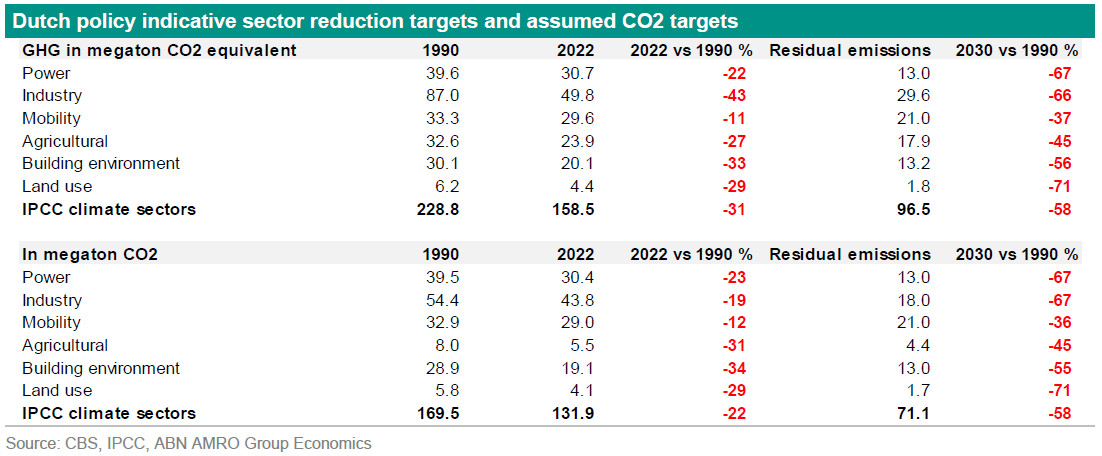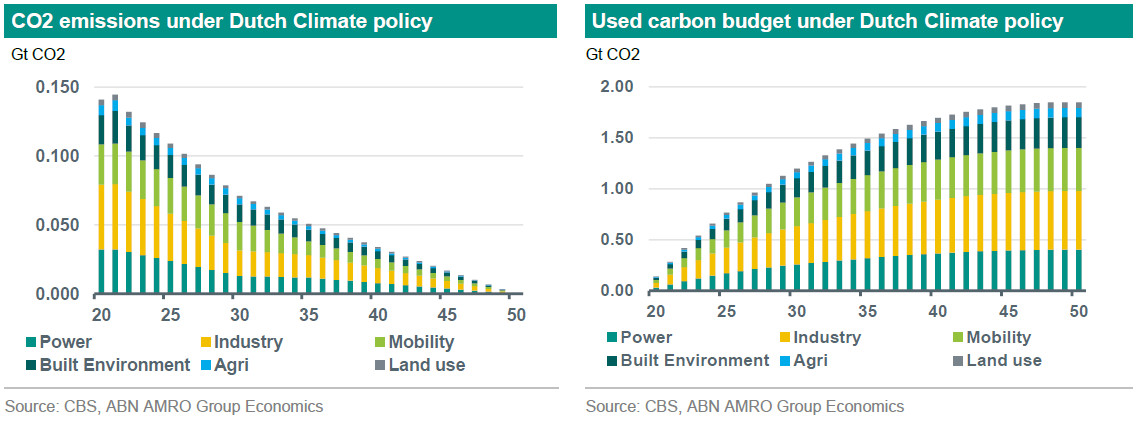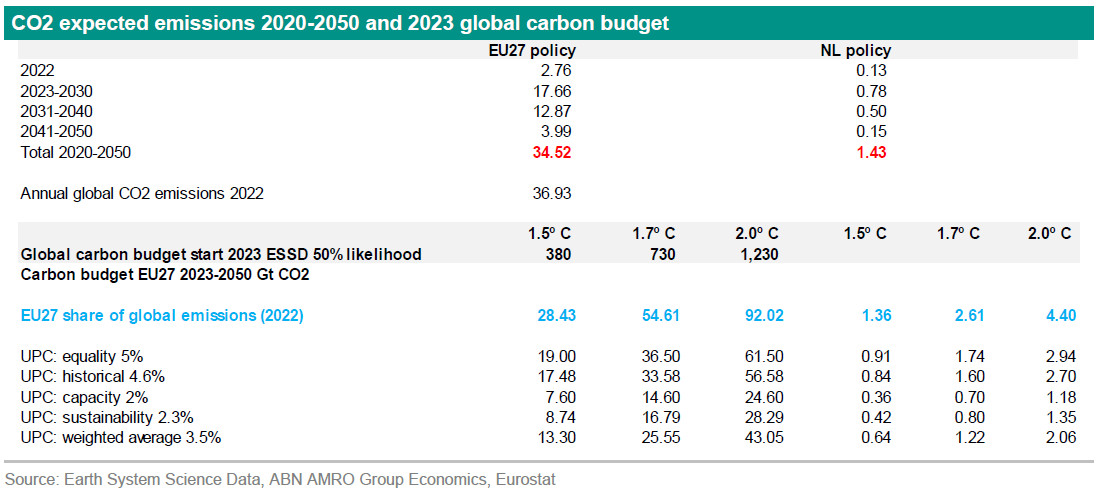ESG Economist - Are Dutch climate targets consistent with 1.5 °C?

Dutch Climate policy has set a target to reduce GHG emissions by a minimum of 55% (but aiming for 60%) by 2030 and to be net-zero in 2050. These targets could translate to a cumulative amount of CO2 emissions for different periods. Dutch Climate policy seems to be ambitious enough under a certain distribution of the global carbon budget for 2020-2050 at a 50% probability. However, since 2020 the global carbon budget has diminished considerably. As a result, climate targets would need to be stepped up in order to remain consistent with a 1.5 degree scenario.
Introduction
Reaching net zero by 2050 is the often heard ambition in climate policy. However, achieving net zero by 2050 is a necessary but not sufficient condition to limit global warming. Specifically, it is not only net zero but also the path towards net zero that is crucial as this will ultimately determine the cumulative amount of carbon and other greenhouse gasses released into the atmosphere, which in turn determine the extent of global warming.The Paris Agreement has as its overarching goal to hold “the increase in the global average temperature to well below 2°C above pre-industrial levels” and pursue efforts “to limit the temperature increase to 1.5°C above pre-industrial levels.” However, in recent years, world leaders have stressed the need to limit global warming to 1.5°C by the end of this century. That’s because the UN’s Intergovernmental Panel on Climate Change (IPCC)indicates that crossing the 1.5°C threshold risks unleashing far more severe climate change impacts, including more frequent and severe droughts, heatwaves and rainfall. In our Sustainaweekly of 6 November 2023 we focussed on the global carbon budget (see here), how this could be distributed and if there was enough carbon budget for the EU27 and the Netherlands under the different methods of distribution. In this report we go a step further. We first start with details of the Dutch Climate policy. Then we calculate how much CO2 would be emitted during a certain period on the country, but also the climate sector level. Finally we compare this with the possible available carbon budgets.
Dutch Climate policy
Dutch Climate policy has a target of reducing emissions (greenhouse gases) by 55 percent by 2030. This target is set in the Climate Act amended 21 July 2023. To be on the safe side, Dutch policy focuses on a 60 percent reduction. To achieve the 55 percent reduction by 2030, no formal sector targets have been agreed upon. Instead, "indicative residual emissions 2030" are set for each sector. Indicative in the sense that too small a reduction in one sector can be compensated by an extra reduction in another sector, so that the 55 percent reduction for all sectors together remains within reach. The parliamentary letter of 26 April 2023 lists indicative residual emissions per sector, which add up to a 58 percent reduction. It concerns greenhouse gas emissions from the Dutch territory. Emissions from international aviation and shipping are not included, nor are emissions from biomass. This approach in line with IPCC. These emissions differ from the emissions of the Dutch economy (see for a full explanation in Dutch).
In this report we focus on the emissions of the Dutch territory according to IPCC. It involves the following climate sectors: industry, power, mobility, built environment, agriculture and land use. The indicative residual emissions for the climate sectors are greenhouse gas emissions in CO2 equivalent. To compare the cumulative CO2 emissions with a possible carbon budget, we have applied the same percentage reduction for indicative residual greenhouse gas emissions and CO2 emissions. The results are in the table below.

These targets are set for 2030. The Climate policy has also set intermediary reduction targets for 2035 (-70%), 2040 (-80%) and net zero in 2050. These are greenhouse gas emission reduction targets in CO2 equivalent versus 1990. We assume that the same reduction targets apply for CO2 only. So for 2030 there are indicative sector specific residual emission targets while the targets for 2035, 2040 and 2050 are for all the climate sectors together. For simplicity we assume that country-wide intermediate and net-zero by 2050 targets apply for all the climate sectors. Thereafter, we add up all the emissions between 2020-2050 and 2023-2050 per sector and then for the Netherlands. The chart on the left below shows the CO2 emission paths for the various sectors until 2050. The graph on the right shows the cumulative emissions the sectors combined. Based on the assumptions above, the Netherlands would emit cumulatively 1.85 Gigaton CO2 until 2050.

Carbon budget concept
A carbon budget is a concept used in climate policy to help to set emissions reduction targets in an effective way. This is the maximum cumulative amount of net global anthropogenic carbon dioxide emissions that could be emitted in order to limit global warming to a given level. However, given the uncertainty in the relationship between any given carbon budget and temperature rise, it is usually expressed in terms of a probability distribution. The IPCC estimated that the global carbon budget at the start of 2020 consistent with limiting warming to 1.5°C with a likelihood of 50% was 500 GtCO2. For a 67% likelihood the global carbon budget was 400 GtCO2 and an 83% likelihood 300 GtCO2. For the 1.7°C and the 2°C scenarios carbon budgets are higher for different likelihoods (see ). According to Earth System Science Data – Global Carbon Budget 2022, the annual manmade CO2 emissions were 36.6 GtCO2 in 2022. The remaining carbon budget for a 50% likelihood to limit global warming to 1.5, 1.7, and 2 °C has, respectively, reduced to 380 GtCO2,730 GtCO2, and 1230 GtCO2from the beginning of 2023 (see ).
2020 carbon budgets for the EU27 and the Netherlands on 50% likelihood
The IPCC estimated global carbon budgets at the start of 2020 to limit warming to 1.5°C, 1.7°C and 2.0°C with different likelihoods. A lower achieved carbon budget increases the confidence in limiting the temperature rise. So the pathway of 1.5°C at a likelihood of 83% has the lowest carbon budget, while the 2°C pathway at a 50% likelihood the highest carbon budget. In this report we focus on what is needed for the 50% likelihood, as this could be seen as the minimum of what is needed. Currently the carbon budget has not been distributed per region or per country. This an ongoing political discussion. There are different approaches to distribute the global carbon budget. One approach is to take a country’s current share of emissions, other approaches are based on equality, history, capacity, sustainability or a weighted average of these (see ).
In 2020 the EU27 emitted 2.69 Gigaton CO2 and the Netherlands emitted 140.0 Megaton CO2 or 0.14 Gigaton. So the Netherlands was responsible for 5.24% of EU emissions. If the distribution of the carbon budget were on a current share basis the EU27 would have a carbon budget of 38.62 for 2020-2050 under the 1.5°C pathway with a 50% likelihood, the Netherlands would have 2.02 Gigaton for 2020-2050 (blue in the table below). Under any of the other approaches to distribute the carbon budget, the EU27 and the Netherlands would have substantially less carbon budget as shown in the table below (numbers under the blue numbers, based on the research of the Universitat Politècnica de Catalunya (UPC), see link above). Under the current share approach the current climate policy of Netherlands seems to be within the carbon budget for a 1.5°C pathway (1.85 versus 2.02 Gigaton). For the EU27 as a whole this is not the case. For the other approaches of distribution and/or the higher probabilities the current climate policy of the Netherlands is not enough for a 1.5°C pathway.

2023 carbon budgets for the EU27 and the Netherlands on 50% likelihood
As indicated above according to Earth System Science Data – the remaining carbon budget for a 50% likelihood to limit global warming to 1.5, 1.7, and 2 °C has, respectively, reduced to 380 GtCO2, 730 GtCO2, and 1230 GtCO2 from the beginning of 2023 (see ). Does this have consequences for the possible carbon budgets for the EU27 and the Netherlands? With the carbon budget at the start of 2023, Dutch climate targets not ambitious enough to stay within the carbon budgets of any of the 1.5°C pathways (depending on the distribution method). The total cumulative emissions for the Netherlands would sum up to 1.43 Gigaton CO2 (number in red under NL in the table below) while there is only 1.36 Gigaton CO2 (the blue number) available under the current share approach and much less under any of the other approaches (see ). This is a gap of 0.07 Gigaton which is almost all the cumulative CO2 emissions of the sector agriculture.

Conclusion
Dutch Climate policy has set a target to reduce greenhouse gas emissions by 55% and to reduce by 60% to be on the safe side by 2030. In 2050 it aims to be net zero. It has also set intermediary targets for 2035 (-70%) and for 2040 (-80%). Next to this there are indicative targets for residual emissions per climate sector for 2030. If we take these targets into account and translate them to CO2 emissions the result is a CO2 policy emissions pathway per climate sector and for the Dutch territory for the period 2020-2050 and 2023-2050. The cumulative emissions can then be compared to the possible carbon budgets for the Netherlands. If we compare the expected cumulative emissions 2023-2050 for the Netherlands with the different carbon budgets, these emissions are between the carbon budgets of 1.5°C and 1.7°C (50% likelihood) for some of the distribution approaches. To stay within the 1.5°C carbon budgets CO2 emission reduction targets for 2030 need to be made more ambitious.
